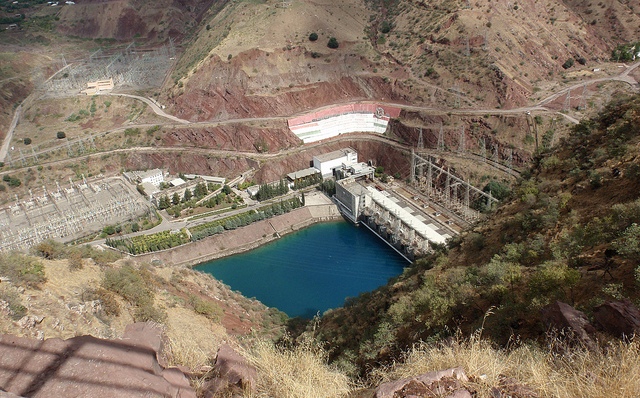
Rogun Dam Project Epitomizes Central Asian Security Dilemmas
Publication: Eurasia Daily Monitor Volume: 9 Issue: 168
By:

Speaking in Kazakhstan on September 7, Uzbek President Islam Karimov strongly voiced his opposition to Central Asian water projects like the Rogun Dam in Tajikistan and the Kambarata-1 hydroelectric project in Kyrgyzstan. Moreover, he insisted, along with Kazakhstan’s President Nursultan Nazarbayev, that any such water project must first receive Kazakhstan’s and Uzbekistan’s approval before construction. The President of Uzbekistan expressed his anxiety about the dams’ upstream effects on the Amu Darya and Syr Darya rivers, which are transnational water resources, and warned that his country could become vulnerable to flooding (Turkishweekly.net, September 7; www.12.uz, September 8). What he did not say is that these water projects reduce the amount of water available to Uzbekistan’s water-wasting cotton economy, which is a crucial element of state control in Uzbekistan and would also free Tajikistan and Kyrgyzstan from Uzbekistan’s efforts to dominate them (Voice of the Islamic Republic of Iran, September 8). Thus it is clear that the Rogun Dam and Kyrgyzstan’s Kambarata-1 projects may lead to substantial conflict in Central Asia.
While Tajikistan’s Rogun Dam project stands at the centerpiece of Dushanbe’s domestic development ambitions, the troubled project also illustrates many of the dilemmas of Central Asian security. First planned in 1959, this dam would harness Tajikistan’s water supplies for the generation of hydroelectric power that it could then use for its own development, for resolving its persistent electricity shortages, and for export to Afghanistan, Pakistan and beyond (Eurasia Review, August 7). However, this program has been dogged by many problems.
In particular Uzbekistan’s government regards the Rogun Dam as a threat. This country depends on the lavish and wasteful use of water for its cotton industry, a mainstay of the regime’s socio-economic control over the population. As a result, Uzbekistan has consistently interfered with Tajikistan’s pursuit of Rogun, blocking its trade, cutting off its energy, and in countless ways waging what amounts to economic warfare against it (www.registan.net, August 13; Eurasia Review, August 7). This situation epitomizes the two sides of the project: one being the decision to use the hydroelectric project as the centerpiece of Tajikistan’s development, but also the fact that Uzbekistan regards that development as a threat to it and thus obstructs all efforts at regional cooperation.
Indeed Tajikistan’s national development strategy aims to triple the country’s GDP by 2015, add 7,000 industrial plants and decrease unemployment by three percent (Imruz News, August 13). Without the Rogun Dam project, those plans have no hope of success. But a failed Tajikistan also undermines the security of all of Central Asia, including Uzbekistan. This does not mean that completion of the project would be a panacea. Another important element in Tajikistan’s economic development strategy is the CASA-1000 electricity transmission project, which aims to supply Tajikistan- and Kyrgyzstan-generated electricity to Pakistan through Afghanistan (see EDM, June 22). Kyrgyz sources report that Kyrgyzstan will be unable to participate in the CASA-1000 energy project on its own without Russian support, a support that implies control as well. Kyrgyzstan lacks sufficient electricity for domestic consumption. Thus, it needs Russian financing of the planned Kambarata-1 hydropower plant and other such plants on the Naryn River to have enough electric power to export via the CASA-1000 transmission lines. But at the same time, if Tajikistan builds the Rogun Dam, Kyrgyzstan’s hydroelectric plants may not be able to economically compete (vesti.kg, July 18). Deutsche Welle also reports that Uzbekistan’s economic warfare against the Rogun Dam has likewise deterred foreign investment necessary to finance the hydropower project in Kyrgyzstan (Rosbalt.ru, August 3), thus simultaneously undermining the success of the regional CASA-1000 project.
Uzbekistan’s attacks on Tajikistan have also had the effect of bringing purely regional issues to Moscow, which seeks to arbitrate them to suit its own interest. In particular the Kremlin has said it would support the Rogun Dam project only if it could be carried out exclusively by Russian companies, an outcome that deprives Tajikistan of any control over its main development project and overall economy (Rosbalt.ru, August 3).
Therefore, the current crisis not only provides opportunities for Russia to try and limit the independence of one or more Central Asian country, it also makes it harder to resolve such conflicts as described here between Bishkek’s and Dushanbe’s interests. Were there a spirit of cooperation, all the issues of power export to Afghanistan and Pakistan from Central Asian countries, including Uzbekistan as well as Kyrgyzstan and Tajikistan, could be approached and dealt with in a spirit of reconciliation—rather than of hostility and even acts of belligerency (Charkhi Gardun Media, July 19). The tensions swirling around this project even affected Uzbekistan’s relations with Kazakhstan. Tashkent allegedly refused transit to Kazakhstan’s troops going to Shanghai Cooperation Organization exercises because of Astana’s position regarding the Rogun Dam at that time (Liter Online, June 20). By the time Presidents Karimov and Nazarbayev met on September 7, however, both shared a negative view of Rogun (see EDM, September 14). Therefore it is not surprising that the Commander in chief of Russia’s Ground Forces, General Vladimir Chirkin told the Russian Federation Council that water sharing issues in Central Asia could lead to armed conflicts in Central Asia (Eurasia Review, August 7).
These statements and the visible rivalries among Central Asian states and Russia make it clear that the questions of one or another Central Asian state’s internal development program cannot be divorced from its overall foreign policy and from the security of the region as a whole. Moreover, the outcome of the struggles over the Rogun Dam and of the complex problems of resolving Central Asia’s complicated water utilization and water sharing issues do not only affect Central Asia. Failure to resolve these problems almost certainly ensures that the solution to the problem of providing power to Pakistan and Afghanistan will inevitably entail suboptimal outcomes. Thus the Rogun Dam is bound up with larger questions that also cry out for resolution, or at least progress toward resolution, well beyond Tajikistan’s and Central Asia’s boundaries.




